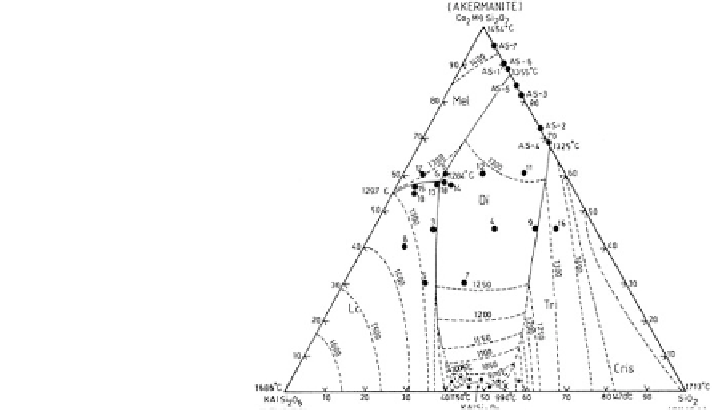Geology Reference
In-Depth Information
akermanite
ss
in the SiO
2
-undersaturated side, and tridymite in the SiO
2
-saturated
portion. Akermanite
ss
and polymorphs of SiO
2
do not coexist in equilibrium. It is
therefore, a join of the system CaO
SiO
2
. It has a thermal barrier at
(Ak
82
Q
18
), which divides the system into SiO
2
-saturated and SiO
2
-undersaturated
portions.
MgO
-
-
11.1 Phase Relations in the System
Leucite-Akermanite-SiO
2
Results are summarized in Fig.
11.2
, which shows that there are three piercing
points:
(1) one at G (Lc
32
Ak
58
Q
10
;Lc
ss
+Mel+Di
ss
+ L) and 1,284
±
5
°
C,
(2) one at H (Lc
55
Ak
2
Q
43
;Lc
ss
+Di
ss
+ Kf + L) and 1,005
±
5
°
C and
(3)
the other at K (Lc
46
Ak
2
Q
52
;D
ss
+ Kf + Tri + L) and 970
±
10
°
C,
respectively.
Subsolidus assemblages in the system, akermanite- leucite-SiO
2
is shown in
Fig.
11.3
. At point A, the diopside-wollastonite join crosses the unstable join
akermanite-SiO
2
(akermanite and tridymite or silica polymorphs do not coexist in
equilibrium) in the CaO
SiO
2
system. Beyond A, toward SiO
2
-saturated side
akermanite
ss
is silicated to form diopside
ss
and wollastonite
ss
. Thus, beyond the line
leucite-A toward SiO
2
-rich side, there should not be any melilite and on the SiO
2
-
saturated side of the line AB, only K-feldspar, tridymite, diopside
ss
and wollastonite
should be stable.
MgO
-
-
Fig. 11.2 Phase relation in
the join leucite-akermanite-
SiO
2
at 1 atm (after Gupta and
Gupta 1997)

Search WWH ::

Custom Search